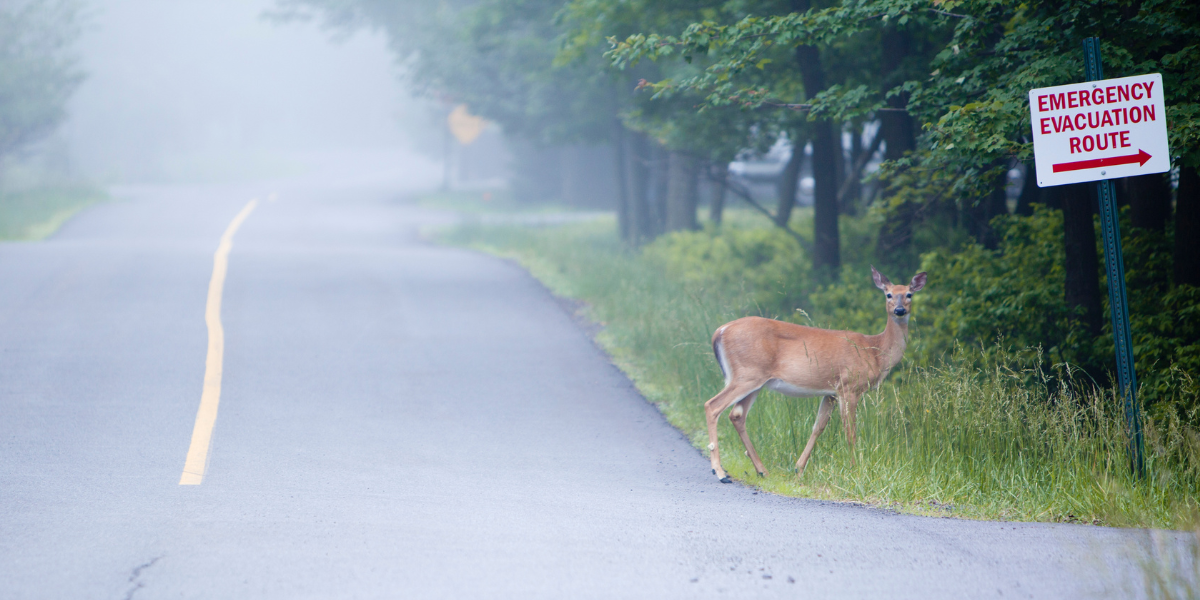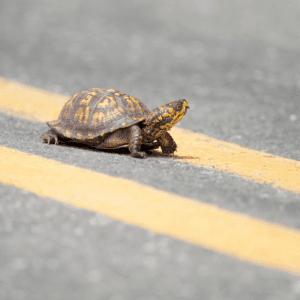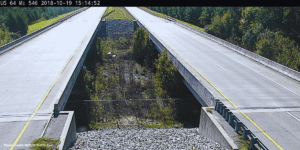From Here To There: Documenting the Stunning Toll of Road-Killed Wildlife

This story was featured in NCWF’s Spring 2023 Journal, and was written by Jeff Beane, herpetology collections manager for the NC Museum of Natural Sciences.
They swim, fly, slither, walk, run, glide, soar, and climb.
They cross creeks and rivers, forests and meadows, ridges
and valleys, and, unfortunately, roads.
For North Carolina’s wildlife, the future is always on the move. Creatures from mountain trout to box turtles to elk and rare freshwater minnows all require connectivity between habitats, whether they range over just a few hundred yards of creek or river to migrations thousands of miles in extent.
Helping wildlife make the connections between their required habitats is a North Carolina Wildlife Federation priority, and the need for such a focus is critical as the state rapidly develops.
The good news? More and more programs are cropping up to help wildlife make the journey up the river, through the woods, and across the road. And each deer or elk or sicklefin redhorse that makes the trip safely can thank NCWF supporters for making it possible to get From Here To There.
Roads take a huge toll on wildlife. Just how huge is unknown. Most studies addressing the issue have been short-term, focusing on mammals and other larger vertebrates—animals representing a small fraction of the total mortality.
Hitting the Pavement – Wildlife Mortality on the Road
To capture a tiny piece of this shameful picture, I’ve monitored a short (0.7-mile, or 1.1-km) stretch of secondary paved road in the Sandhills of southern Moore County, as often as possible, for over 20 years. I began on October 27, 2002, recording all road-killed vertebrates detected. I selected this route for no reason other than convenience; one end of the road abuts land I purchased in October 2002. Habitats along the stretch include blackwater stream floodplain, braided stream, beaver swamp, sand ridge with mixed pines and hardwoods, a recent clearcut, a horse farm, agricultural fields, and the edge of a rural yard. The route coincidentally includes the type locality of the recently described Carolina Sandhills salamander, Eurycea arenicola.
As of this writing, I’ve completed 2,196 pedestrian surveys (2,151 complete, 45 partial) and 3,300 vehicle surveys. A complete pedestrian survey consists of walking the stretch down and back; a partial survey is anything less than a complete circuit. A vehicle survey is any one-way pass in a vehicle, from either direction. Walking briskly, stopping only for road-kill, a pedestrian survey takes approximately 29 minutes. In recent years, however, I’ve compiled ebird lists during some walks, so surveys now often take an hour or longer. Vehicle passes, sufficiently slow to detect smaller road-kills, take about three minutes. I count passing vehicles during pedestrian surveys. It’s not a terribly busy road (typically between 20 and 40 vehicles per hour), and traffic volume fluctuates, but has increased slightly over the years. Slight decreases were noticeable in 2008, when gas prices exceeded $4 per gallon following Hurricane Katrina, and in 2020, at the beginning of the COVID-19 pandemic. During the first decade, my estimates of vehicles per day ranged from 436 in 2003 to 609 in 2007 (N.C. Department of Transportation figures for those two years compared closely—480 and 660). Traffic is heaviest during weekday rush hours and lightest during late nights and on Sunday mornings. Most surveys have been on Fridays, Saturdays, and Sundays since I work in Raleigh during the week. I have averaged slightly over two surveys per week.
 As of this writing, I have documented 6,311 individual DOR (dead on road) vertebrates, of 118 species (22 amphibians, 40 reptiles, 39 birds, 17 mammals). The majority (ca. 73 percent) were amphibians, followed by reptiles (ca. 21 percent), with birds and mammals making up only about 3 percent each. (I also found two fish—an American eel and a golden shiner—but I’m certain they were deposited on the creek bridge by anglers and not killed by vehicles.) I was certainly not surprised to learn that pedestrian surveys are more effective than vehicular surveys in detecting road-kill, but how much more effective was impressive. On foot, I turned up at least one DOR vertebrate 76 percent of the time (93.7 percent of total), whereas vehicular surveys turned up at least one only 8.2 percent of the time (6.3 percent of total). Regardless of how slowly you drive, or how good your eyes are, you won’t detect tiny frogs, lizards, and salamanders that are ground into the pavement or in roadside grass. Such creatures account for a high percentage of the total. I did not even attempt invertebrates, which represent the vast majority of road mortality.
As of this writing, I have documented 6,311 individual DOR (dead on road) vertebrates, of 118 species (22 amphibians, 40 reptiles, 39 birds, 17 mammals). The majority (ca. 73 percent) were amphibians, followed by reptiles (ca. 21 percent), with birds and mammals making up only about 3 percent each. (I also found two fish—an American eel and a golden shiner—but I’m certain they were deposited on the creek bridge by anglers and not killed by vehicles.) I was certainly not surprised to learn that pedestrian surveys are more effective than vehicular surveys in detecting road-kill, but how much more effective was impressive. On foot, I turned up at least one DOR vertebrate 76 percent of the time (93.7 percent of total), whereas vehicular surveys turned up at least one only 8.2 percent of the time (6.3 percent of total). Regardless of how slowly you drive, or how good your eyes are, you won’t detect tiny frogs, lizards, and salamanders that are ground into the pavement or in roadside grass. Such creatures account for a high percentage of the total. I did not even attempt invertebrates, which represent the vast majority of road mortality.
Just over half (50.7 percent) of all mortality consisted of just seven species: southern toad, spring peeper, green treefrog, ground skink, green frog, eastern newt, and green anole. Southern toads alone made up over 19 percent. The overwhelming majority (99.75 percent) of species killed were native; only 16 individuals of three species were introduced (two European starlings, 10 house mice, four house cats). One state-listed Threatened species (southern hognose snake) and two listed as Special Concern (eastern coachwhip, timber rattlesnake) were included, as well as four on the N.C. Natural Heritage Program (NHP)’s Watch List (Carolina Sandhills salamander, spotted turtle, scarlet snake, scarlet kingsnake). These seven species comprised 1.25 percent of the total. Also included were five bird species either state-listed, tracked by NHP, or on its Watch List based solely on their breeding status in the state, but two of them (hermit thrush, yellow-rumped warbler) are very common winter residents, and the other three (chuck-will’s-widow, eastern whip-poor-will, loggerhead shrike) are relatively common breeders in the Sandhills.
A few things surprised me. Several species, such as American bullfrog, southern leopard frog, eastern gray squirrel, and corn snake, turned up less frequently than I expected. I would never have predicted hermit thrush to be the number-one bird killed (17 individuals, 0.27 percent of the total), or that eastern red bat would be second among mammals (‘possums, not surprisingly, were number one). Unexpected species included queen snake, northern waterthrush, ruby-throated hummingbird, marsh rice rat, least shrew, tricolored bat, and evening bat. Carpenter frogs are relatively common in the beaver swamp along one stretch of the route, but I never found one road-killed.
So far, this project has occupied well over a thousand hours of my life. But besides merely counting dead things, the 1,500-plus miles I’ve walked have translated to fresh air and exercise (walking being among the few forms of exercise I truly enjoy). I’ve contributed substantial data to ebird and the NC Bird Atlas, seen many creatures alive, taken many photographs, found a total of $10.06 in cash (OK, so road-kill surveys don’t pay well), and salvaged at least 141 animals (60 snakes, 43 frogs, 14 lizards, 10 turtles, six salamanders, four birds, four mammals) for museum specimens.
 One study I read estimated that about one million vertebrates are killed on U.S. roads every day. I’m not sure how they arrived at that figure. Making a couple of wild assumptions (e.g., assuming I detected every single mortality—which I certainly did not— and that vertebrate mortality on my survey stretch is average for U.S. roads), I multiplied the vertebrates killed on my stretch (about 1.2 per mile per day) by the number of miles of roads in the U.S. (not including private roads, jeep trails, driveways, etc.) and came up with 6,311,100 vertebrates per day.
One study I read estimated that about one million vertebrates are killed on U.S. roads every day. I’m not sure how they arrived at that figure. Making a couple of wild assumptions (e.g., assuming I detected every single mortality—which I certainly did not— and that vertebrate mortality on my survey stretch is average for U.S. roads), I multiplied the vertebrates killed on my stretch (about 1.2 per mile per day) by the number of miles of roads in the U.S. (not including private roads, jeep trails, driveways, etc.) and came up with 6,311,100 vertebrates per day.
Crossing the Double Line – Roads and Fragmentation
Regardless of the true figure, is it worth it? Humans—Americans especially—are in love with auto mobiles and consider them vital. But they aren’t. Only a tiny fraction of our time on Earth has included the internal combustion engine, or even the wheel. But in less than a century we’ve crisscrossed the planet’s land mass with death-dealing corridors.
Some folks scratch their heads and wonder why so many species are declining. To me, there’s no mystery. Thousands of expensive wildlife underpasses may help but won’t solve the problem. Real solutions—drastically reducing our out-of-control population, relinquishing our dependency on automobiles, and building awareness of and appreciation for the planet’s other residents—are consistently rejected.
Meantime, especially for those few of us who cherish all species as family, and actually care whether we run over a toad en route to the strip mall, the situation remains tragic. If all I can do is document a tiny sliver of it, then that’s what I’ll continue to do.
Work to Lessen Wildlife Mortality on Road-ways

North Carolina’s population is constantly increasing.
As more and more people move here, the landscape changes with additional development, new roads, additional road lanes, and over all, more vehicles on the highways. Unfortunately, the effect on wildlife from those actions often results in habitat loss, habitat fragmentation, and increased wildlife vehicle collisions.
This is not new; the North Carolina Wildlife Resources Commission (NCWRC) has been working with the North Carolina Department of Transportation (NCDOT) for decades to address these impacts during project planning.
Recently, the two agencies developed a Memorandum of Understanding (MOU) that reinforces the shared commitment of our agencies to work together to improve wildlife passage in North Carolina. This MOU emphasizes improved data collection for wildlife vehicle mortality, continued monitoring of wildlife crossing structures, identification of new crossings and wildlife mitigation strategies, and continued collaboration during NCDOT’s project planning processes.
Like most sciences, road ecology is constantly evolving with the addition of more data and technology that help improve decisions. NCWRC and NCDOT are committed to working together to improve North Carolina’s roads for both wildlife and the traveling public.
Written By:
– Jeff Beane, herpetology collections manager for the NC Museum of Natural Sciences.

